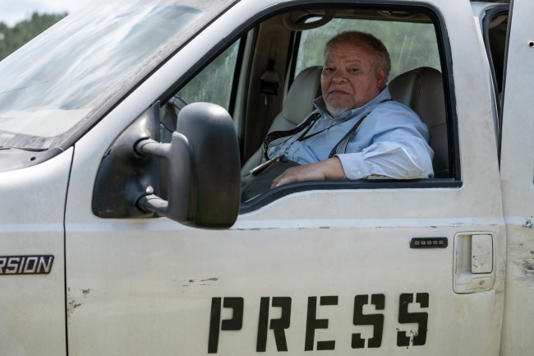Alex Garland’s new movie is set against a backdrop of dystopian dictatorship, extremist paramilitary groups, and journalism as a fading hope.
It’s a world so familiar to our own on the eve of a possible Donald Trump re-election and still in the shadow of his last term. Civil War follows a photojournalist named Lee (Kirsten Dunst) and her Reuters colleagues from New York into martial law-ravaged Washington, D.C.
Jessie joins Lee, traumatized by years shooting images of war close-up yet at a remove, on a journey to the White House with boozing fellow journo Joel (Wagner Moura) and Lee’s mentor Sammy (Stephen McKinley Henderson). The president (Nick Offerman) is expected to surrender as the Western Forces and the Florida Alliance narrow in.
Garland, who wrote the film in 2020 after COVID began, was “selective to what was presented according to what the journalists were moving through.” That means “Civil War” doesn’t give a history of the world heretofore now, where what we’re seeing is mostly the aftermath of apocalyptic images that we can easily imagine.
“If you unpack some of the statements within the moments, the political world-building is probably less ambiguous than it might appear at first blush. But that’s probably something to do with the grammar of the way film often functions, which is to be very, very clear about everything at every moment. And because this is doing that less so, it feels like there’s an absence of something, but I’m not sure there really is an absence,” Garland said.
When the trailer launched, the queries online were “who is it for if not especially for those of us who feel like we’re already living in a “civil war”?
The film’s military tropes are actually muted and limited to a few scenes in “Civil War” compared to the more contemplative movie about journalism Garland has made.
The first trailers suggested: See a movie that will remind you of the Capitol riots.
It’s about journalists as observers, a last beacon of objectivity amid the binaries (red vs. blue, reactionary vs. progressive) that lead to conversations shutting down. (Though both Garland and “Civil War” don’t get terribly specific about it, which works both for and against the movie at times, depending on how much the viewer or listener wants to be fed.) “I feel like right now we don’t have a shortage of the strong shutting down assertions,” Garland said.
The portrait of journalists Garland depicts might feel utopian to any journalists in the audiences – with the mere flash of a press badge or the word “press” emblazoned on their beat-up white van, Lee and her team seem to have carte blanche to wave through hellfire.
“Attempting to remove bias and usually not using the word ‘I,’ trying to be objective in that reporting, that was the dominant form of journalism for a long time, and it had the benefit of feeling more trustworthy than news organizations that are effectively working as propagandists in one way or another,” Garland said. “So I don’t think [the portrayal of journalism in ‘Civil War’ is utopian]. I think all of those journalists, who are in a way calmer, more balanced, and fairer and more reflective; they all exist. They can be found working busily and in some ways effectively right now, except they’re not as effective as you would want them to be.”
Garland said of those journalists, embodied in Dunst’s coolly measured Lee: “They don’t have the traction they used to have because they don’t have the trust they used to have, not because of anything they’re doing, but what’s happening around them, which is the arrival, the dominance of bias on one level. …
Journalism has an actual societal function as a check and a balance against any government institutions. … I miss reporters as the source of factual information of what’s happening in the world.”
The horrific events and imagery mount in Civil War, culminating in a harrowing scene involving Jesse Plemons as extremist in pink sunglasses and ending in a mass grave of entangled corpses.
Lee and her cohorts retain a cold objectivity of their own, long-trained in the quote-unquote art of war photography to capture inferno from afar. Well, until at least one of them snaps.
The character is hardened by her profession, and therefore becomes a screen upon which the audience can project their own response to images of war.
An A24 release, “Civil War” opens in theaters April 12.





